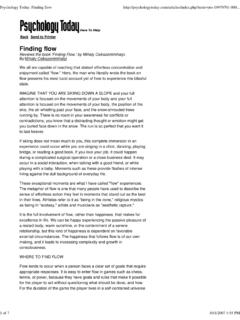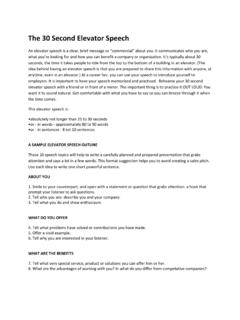Transcription of Places to Intervene in a System
1 leverage PointsPlaces to Intervene in aSystemby Donella MeadowsThe Sustainability Institute 3 Linden Road Hartland VT 05048 Phone 802-436-1277 FAX 802-436-1281 Email: additional copies of this report, send US$10 to The Sustainability by The Sustainability Institute, shorter version of this paper appeared in Whole Earth, winter who do systems analysis have a greatbelief in leverage points . These are placeswithin a complex System (a corporation, aneconomy, a living body, a city, an ecosys-tem) where a small shift in one thing canproduce big changes in idea is not unique to systems analy-sis it s embedded in legend. The silver bul-let, the trimtab, the miracle cure, the secretpassage, the magic password, the single heroor villain who turns the tide of history.
2 Thenearly effortless way to cut through or leapover huge obstacles. We not only want tobelieve that there are leverage points , wewant to know where they are and how toget our hands on them. leverage points arepoints of systems analysis community has alot of lore about leverage points . Those of uswho were trained by the great Jay Forresterat MIT have all absorbed one of his favoritestories. People know intuitively whereleverage points are, he says. Time after timeI ve done an analysis of a company, and I vefigured out a leverage point in inventorypolicy, maybe, or in the relationship betweensales force and productive force, or in per-sonnel policy. Then I ve gone to the com-pany and discovered that there s already a lotof attention to that point.
3 Everyone is tryingvery hard to push it in the wrong direction! leverage points : Places to Intervene in a Systemby Donella H. MeadowsThe classic example of that backwardintuition was my own introduction to sys-tems analysis, Forrester s world by the Club of Rome to show howmajor global problems poverty and hun-ger, environmental destruction, resourcedepletion, urban deterioration, unemploy-ment are related and how they might besolved, Forrester made a computer modeland came out with a clear leverage Not only population growth, buteconomic growth. Growth has costs as wellas benefits, but we typically don t count thecosts among which are poverty and hun-ger, environmental destruction, and so on the whole list of problems we are trying tosolve with growth!
4 What is needed is muchslower growth, and in some cases no growthor negative world s leaders are correctly fixatedon economic growth as the answer to virtu-ally all problems, but they re pushing withall their might in the wrong of Forrester s classics was hisurban dynamics study, published in 1969,which demonstrated that subsidized low-income housing is a leverage Theless of it there is, the better off the city is even the low-income folks in the city. Thatis because subsidized housing withoutequivalent effort at job creation for the1 Forrester, Wo r l dDynamics. Portland,Oreg.: Productivity Press, Forrester, UrbanDynamics. Portland,Oreg.: Productivity Press, points : Places to Intervene in a System2inhabitants severely disrupts a city s employ-ment/housing ratio, effectively increasingunemployment and welfare costs anddespair.
5 This model came out at a time whennational policy dictated massive low-incomehousing projects. Forrester was those projects are being torn down incity after city. Forrester was That s Forrester s wordto describe complex systems. Leveragepoints are not intuitive. Or if they are, weintuitively use them backward, systemati-cally worsening whatever problems we aretrying to systems analysts I know have comeup with no quick or easy formulas for find-ing leverage points . When we study a sys-tem, we usually learn where leverage pointsare. But a new System we ve never encoun-tered? Well, our counterintuitions aren t thatwell developed. Give us a few months oryears to do some computer modeling andwe ll figure it out.
6 And we know from bitterexperience that, because of counter-intuitiveness, when we do discover thesystem s leverage points , hardly anybody willbelieve frustrating, especially for those of uswho yearn not just to understand complexsystems, but to make the world work one day, I was sitting in a meetingabout how to make the world work better actually it was a meeting about how the newglobal trade regime, NAFTA and GATTand the World Trade Organization, is likelyto make the world work worse. The more Ilistened, the more I began to simmer in-side. This is a huge new System people areinventing! I said to myself. They haven tthe slightest idea how this complex struc-ture will behave, myself said back to me.
7 It s almost certainly an example of crank-ing the System in the wrong direction it saimed at growth, growth at any price!! Andthe control measures these nice, liberal folksare talking about to combat it smallparameter adjustments, weak negative feed-back loops are way too puny!!! Suddenly, without quite knowing whatwas happening, I got up, marched to the flipchart, tossed over to a clean page, and wrote: Places to Intervene in a System (in increasing order of effectiveness) , parameters, numbers (subsi-dies, taxes, standards) negative feedback positive feedback flows and nodes of rules of the System (incentives,punishments, constraints) distribution of power over the rules ofthe goals of the mindset or paradigm out of which thesystem its goals, power structure, rules,its culture Institute, December, 1999 Everyone in the meeting blinked in sur-prise, including me.
8 That s brilliant! some-one breathed. Huh? said someone realized that I had a lot of explainingto also had a lot of thinking to do. Aswith most of the stuff that comes to me inboil-over mode, this list was not exactlytightly reasoned. As I began to share it withothers, especially with systems analysts whohad their own lists, and with activists whowanted to put the list to immediate use,questions and comments came back thatcaused me to rethink, add and delete items,change the order, add a minute I ll go through the list thatI ended up with, explain the jargon, andgive examples and exceptions. The reasonfor this introduction is to place the list in acontext of humility and to leave room forevolution.
9 What bubbled up in me that daywas distilled from decades of rigorous analy-sis of many different kinds of systems doneby many smart people. But complex systemsare, well, complex. It s dangerous to gener-alize about , what you are about to read is a workin progress. It s not a simple, sure-fire recipefor finding leverage points . Rather, it s aninvitation to think more broadly about themany ways there might be to get systems , in the light of a cooler dawn, is arevised list: Places to Intervene in a System (in increasing order of effectiveness)12. Constants, parameters, numbers (such assubsidies, taxes, standards)11. The sizes of buffers and other stabilizingstocks, relative to their The structure of material stocks and flows(such as transport networks, populationage structures) lengths of delays, relative to the rateof System strength of negative feedback loops,relative to the impacts they are trying tocorrect gain around driving positive structure of information flows (whodoes and does not have access to whatkinds of information) rules of the System (such as incen-tives, punishments, constraints) power to add, change, evolve, or self-organize System goals of the mindset or paradigm out of which thesystem its goals, structure,rules, delays,parameters power to transcend paradigmsLeverage points .
10 Places to Intervene in a System4To explain parameters, stocks, delays,flows, feedback, and so forth, I need to startwith a basic state of the System is whateverstanding stock is of importance: amount ofwater behind the dam, amount of harvest able wood in the forest, number of peoplein the population, amount of money in thebank, whatever. System states are usuallyphysical stocks, but they could be nonma-terial ones as well: self-confidence, degreeof trust in public officials, perceived safetyof a are usually inflows that increasethe stock and outflows that decrease increase the money in the bank;withdrawals decrease it. River inflow andrain raise the water behind the dam; evapo-ration and discharge through the spillwaylower it.




